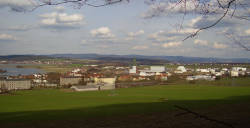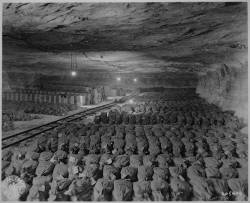Erlebnis Bergwerk Merkers
Useful Information


| Location: |
At Merkers.
From Eisenach, A4 exit 39 weat follow B84 south west to Dorndorf, turn left to Merkers onto B62. A4 exit 33 Friedewald, B62 18 km east to Vacha, turn left onto B62, 7 km to Merkers. A7 exit 91 Fulda Nord, B84 19 km north east to Nünfeld, turn right onto B84 to Vacha, B62 7 km to Merkers. |
| Open: |
All year Tue-Sun 9:30, 13:30.
Prebooking is advisable. Additional tours after appointment. [2012] |
| Fee: |
MAR to NOV:
Adults EUR 20, Children (17-18) EUR 15, Children (10-16) EUR 12, Family (2+1) EUR 46, additional Child EUR 8.
Groups: Adults (10+) EUR 18, Adults (20+) EUR 17, Adults (30+) EUR 16.50, Children (17-19) EUR 13, Children (10-16) EUR 11. DEC to FEB: Adults EUR 18, Children (17-18) EUR 13, Children (10-16) EUR 11, Family (2+1) EUR 41, additional Child EUR 6. Groups: Adults (10+) EUR 17, Adults (20+) EUR 16, Adults (30+) EUR 15, Children (17-19) EUR 12, Children (10-16) EUR 10. [2012] |
| Classification: |
 Salt Mine Salt Mine
 Vault Vault
 Geode
Potassium mine Geode
Potassium mine
|
| Light: |
 Electric Light Electric Light
|
| Dimension: | T=20-28 °C |
| Guided tours: | D=3 h. V=70,000/a [2000] V=80,000/a [2011] |
| Photography: | |
| Accessibility: | |
| Bibliography: | |
| Address: |
K+S KALI GmbH, Erlebnis Bergwerk Merkers, Postfach 1163, D-36267 Philippsthal, Tel: +49-3695-614101.
E-mail: |
| As far as we know this information was accurate when it was published (see years in brackets), but may have changed since then. Please check rates and details directly with the companies in question if you need more recent info. |
|
History
| 1944 | Gold, money, artworks and other valuables moved to Merkers from Berlin. |
| 25-APR-1945 | 90th Div, U.S. Third Army, discovers the gold and other treasure at Merkers. |
| 1980 | Kristallgrotte (Crystal Grotto) discovered. |
Geology
This is only one mine in the Werra-Fulda-Kalirevier, a huge deposit of potassium between the rivers Werra and Fulda. It has a size of about 1,000 square kilometers and goes from Berka in the north to Fulda in the south, Bad Salzungen in the east and Bad Hersfeld in the west. During the Zechstein era (Perm, about 230 Ma) this area was a huge depression, cut off from the sea. The climate was warm and dry, arid or semi-arid, desert like. Either continually through a narrow strait, or during floods or storms, the seawater flew into the depression, where the water evaporated. The salt and mineral dissolved in the seawater were deposited layer by layer. This theory was formulated by the geologist Carl Christian Ochsenius (*1830-✝1906) as early as 1877 as the barrent theory (threshold theory) and is still valid today, albeit with slight modifications due to the findings of plate tectonics.
The salt is covered by a layer of Werra-Ton (clay), which is water resistant. It protects the soluble salt and anhydrite from being dissolved. The salt layers are several hundred meters high in some places.
Description


The Merkers mine was not only an enormous mine for potassium, but it was once used as a bunker for the gold treasure of the German state. Today the mine is abandoned and used as a so called Erlebnisbergwerk (experience mine). A tour is very interesting but also rather long and strenuous. And the number of tours is small, so prebooking is essential.
The visitor enters the mine through the elevator going down to sublevel two at 500 m below ground. The temperature is here 20 to 28 °C, so warm clothes are definitely not necessary! Now the tour through the mine begins. Due to the enormous size, visitors are driven to the various sights in small trucks with benches on the back.
First stop is the underground mining museum, showing the history of potassium mining along the Werra river. Nearby mines at Kaiserroda and Heiligenroda are mentioned, also the brine springs at Salzungen. Many items of the exhibiton may be touched and explored by the visitors, which makes the visit a special experience.
The so-called Großbunker is a huge chamber, which was excavated 1989 to store up to 50,000 tons of salt. The hall is 250 m long, 22 m wide and 14 m high. It contains the biggest excavator which exists underground, it was assembled underground. The mining capacity was higher than the conveying capacity, so some salt was stored at the chamber from Monday to Friday. On weekends only two miners worked in the mine, which were maintaining the conveying of the already mined salt.
The next stop has a very special history. This hall was used to store gold in the year 1945. The gold und devices of the Deutsche Reichsbank (German Empire Bank) were stored here for some weeks. So the mine became a vault. The gold was retrieved immediately after the war by the American army. You have probably seen the movie Monument Men with George Clooney, the scene with the gold bars and artworks in the mine is based on this site. In reality the 90th Div, U.S. Third Army, discovered the gold and other treasure at Merkers. One of the pictures on this page shows U.S. soldiers examining a famous painting, Wintergarden, by the French impressionist Edouard Manet. Another shows General Eisenhower inspecting the artworks.
The geologic path shows various specialties of the local geology. A main topic is the volcanism of this area called Rhön. There are several dykes cutting through the mine, which are easily visible alon the path. But big mining machinery is also an important topic of this section.
The highlight of every tour is the Kristallgrotte (Crystal Grotto), a huge chamber filled with enormous salt crystals. The biggest crystals are more than 1 m long. Salt forms cubic crystals, which are bright like diamonds. The grotto is a natural cave in the rock salt which was filled with water. The water dissolved salt and caused the growth of the salt crystals by precipitation. Such a structure is called a geode.
 Search DuckDuckGo for "Erlebnis Bergwerk Merkers"
Search DuckDuckGo for "Erlebnis Bergwerk Merkers" Google Earth Placemark
Google Earth Placemark Erlebnis Bergwerk Merkers - Die Welt des weißen Goldes, official website. (
Erlebnis Bergwerk Merkers - Die Welt des weißen Goldes, official website. ( )
) Index
Index Topics
Topics Hierarchical
Hierarchical Countries
Countries Maps
Maps